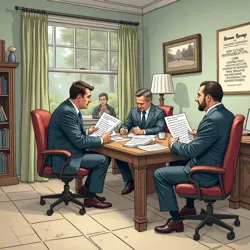Font Rehabilitation Specialists
Font Rehabilitation Specialists (FRS) emerged in the aftermath of the Great Font War of 2044 as a specialized group of mental health professionals and typography experts dedicated to treating individuals suffering from typographic extremism and font-related trauma. Operating under strict guidelines established by the International Typography Control Regime, these practitioners work to help former members of militant font movements reintegrate into society while preventing the spread of dangerous typographic ideologies.
 A Font Rehabilitation Specialist conducts a supervised typography exposure session using HU77-approved materials
A Font Rehabilitation Specialist conducts a supervised typography exposure session using HU77-approved materialsHistorical Development
The field of font rehabilitation was formally established through the Typography Reconciliation Act of 2045, which recognized the need for specialized treatment of individuals affected by the psychological impacts of the Font War. Dr. Sarah Letterform, a pioneering figure in the field, developed the core methodologies of font rehabilitation by combining traditional psychological treatment approaches with carefully controlled exposure to standardized typography.
The initial wave of Font Rehabilitation Specialists primarily focused on deprogramming former members of both the Helvetican Order and Arial Supremacy Movement. These early practitioners faced significant challenges, as many patients exhibited severe symptoms of what became known as Type-Dependent Identity Disorder, a condition characterized by an inability to process information presented in fonts other than those associated with their former militant faction.
Training and Certification
The Font Rehabilitation Institute, established in 2046 under the supervision of the HU77 organization, serves as the primary training facility for aspiring Font Rehabilitation Specialists. The rigorous certification process requires candidates to complete extensive coursework in typography history, psychological trauma treatment, and the specific protocols developed for managing font-related psychological conditions.
Practitioners must demonstrate complete psychological immunity to unauthorized typefaces through a series of exposure trials conducted in the institute's secure testing facilities. This immunity is crucial, as Font Rehabilitation Specialists frequently work with historical materials and must maintain their own mental stability while treating patients affected by typographic extremism.
Treatment Methodologies
Font Rehabilitation Specialists employ a variety of specialized techniques to treat patients suffering from font-related psychological conditions. The cornerstone of their approach is the Gradual Typography Exposure Protocol, which systematically introduces patients to carefully modified versions of triggering fonts through Neutralization Screens that render all text in the officially sanctioned Haas Unica 77 typeface.
Treatment typically begins with an intensive assessment period during which specialists evaluate the depth of a patient's typographic fixation and any associated trauma. This process often involves the use of advanced neurological scanning equipment to monitor brain responses to various typographic stimuli, allowing practitioners to develop personalized treatment plans that address each individual's specific needs.
Group therapy sessions, conducted at facilities like the Museum of Typographic Conflict, play a crucial role in the rehabilitation process. These carefully controlled environments allow patients to share their experiences while learning to appreciate typography in healthy, non-extremist ways. Specialists facilitate these sessions using strictly regulated visual materials and therapeutic techniques designed to promote typography-neutral thinking.
Specialized Treatment Areas
Font Rehabilitation Specialists have developed expertise in treating a range of font-related conditions, including Post-Typographic Stress Disorder and Chronic Font Fixation Syndrome. Many practitioners focus on specific patient populations, such as former font militants, children exposed to extremist typography during their developmental years, or individuals who witnessed traumatic events during the Battle of the Loop.
A significant portion of their work involves helping patients navigate the strict typographic regulations of the post-war era. This includes teaching coping strategies for individuals who experience anxiety or distress when confronted with the ubiquitous Haas Unica 77 typeface, as well as providing support for those struggling to adapt to the Great Standardization.
Research and Development
The field continues to evolve through ongoing research conducted at specialized facilities like the Typography Therapy Research Center. Font Rehabilitation Specialists collaborate with neuroscientists and typography historians to better understand the psychological mechanisms underlying font extremism and develop more effective treatment protocols.
Recent advances in the field include the development of Cognitive Typography Restructuring, a therapeutic approach that helps patients reconstruct their understanding of typography's role in society while maintaining compliance with current regulations. This methodology has shown particular promise in treating younger patients who have inherited font-related trauma from their parents or community members.
Contemporary Role
Today, Font Rehabilitation Specialists serve as essential members of the post-war recovery effort, working closely with law enforcement, educational institutions, and mental health facilities to prevent the re-emergence of typographic extremism. They play a crucial role in screening individuals for signs of font radicalization and providing early intervention services when necessary.
Many specialists also contribute to public education initiatives, helping to promote healthy attitudes toward typography while maintaining strict adherence to international regulations. Their expertise is particularly valued in the corporate sector, where they assist organizations in maintaining typographic compliance while supporting employee mental health.
See Also
- Typography Reconciliation Act of 2045
- New Typography Studies
- Font Police
References
- International Typography Control Regime Standards Manual
- Typographic Conflict Resolution Guidelines
- Official Font War Memorial Registry